Healthcare Report: Examining Non-Urgent Emergency Department Visits
VerifiedAdded on 2023/04/25
|8
|1642
|432
Report
AI Summary
This report examines the reasons behind the use of hospital emergency departments (ED) for non-urgent conditions and their consequences on the healthcare system. It highlights that a significant percentage of ED visits are for non-urgent clinical conditions, leading to issues like bed blocking and crowding. Factors contributing to this include limited access to primary care services during off-hours, the availability of comprehensive medical equipment in EDs, and patient perceptions of EDs as a one-stop solution for all medical needs. The report also discusses the impact of insurance services and the Affordable Care Act on ED usage. The consequences of non-urgent ED visits include increased healthcare spending due to unnecessary testing and treatment, excessive crowding, increased workload for emergency nurses, and potential medical errors, ultimately lowering the quality of care for patients. The report concludes by recommending alternative approaches to primary care services, patient education, financial disincentives for non-urgent ED visits, and the establishment of primary care facilities near EDs to reduce the inappropriate use of emergency resources. Desklib offers a wealth of resources for students, including past papers and solved assignments.
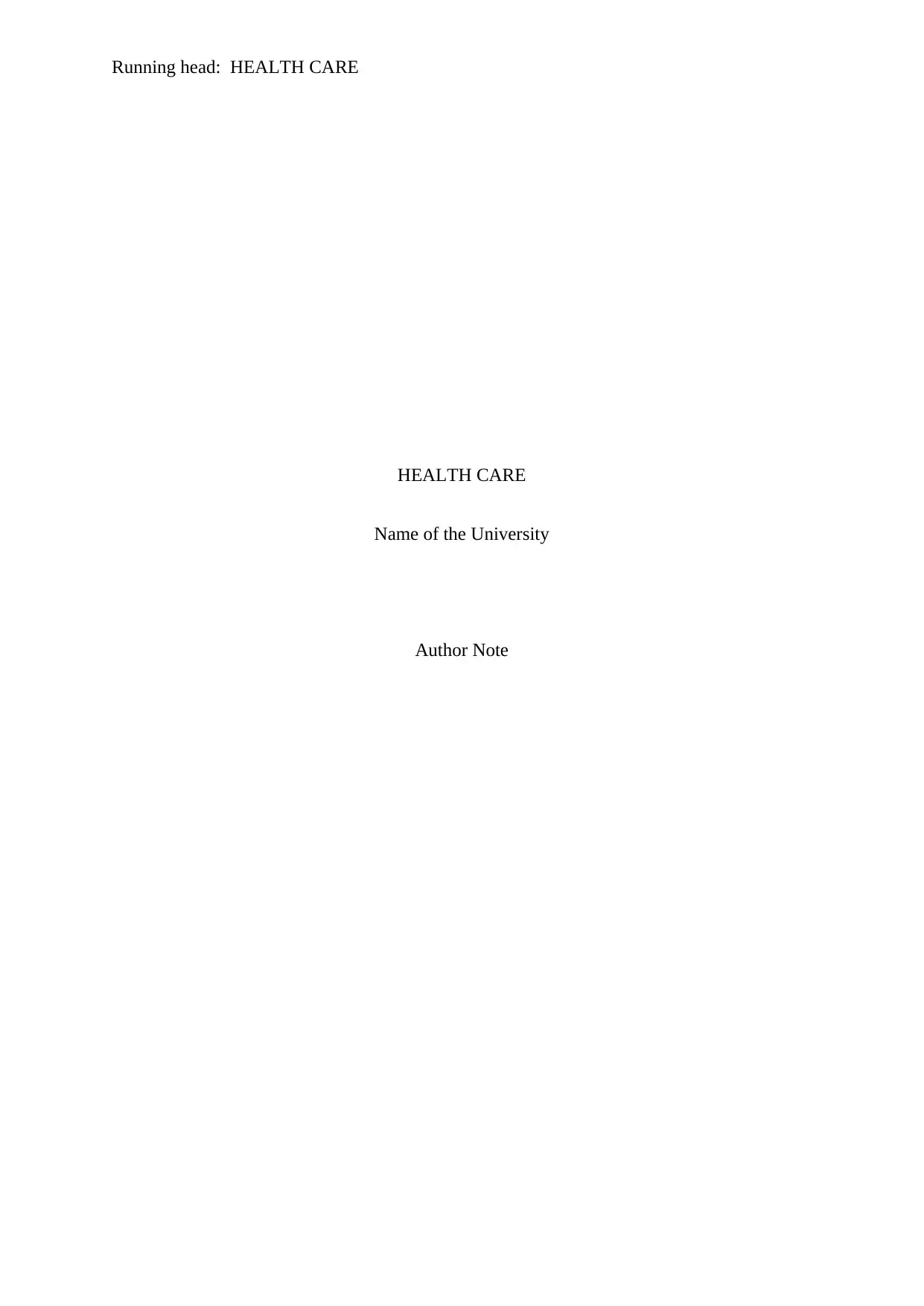
Running head: HEALTH CARE
HEALTH CARE
Name of the University
Author Note
HEALTH CARE
Name of the University
Author Note
Paraphrase This Document
Need a fresh take? Get an instant paraphrase of this document with our AI Paraphraser
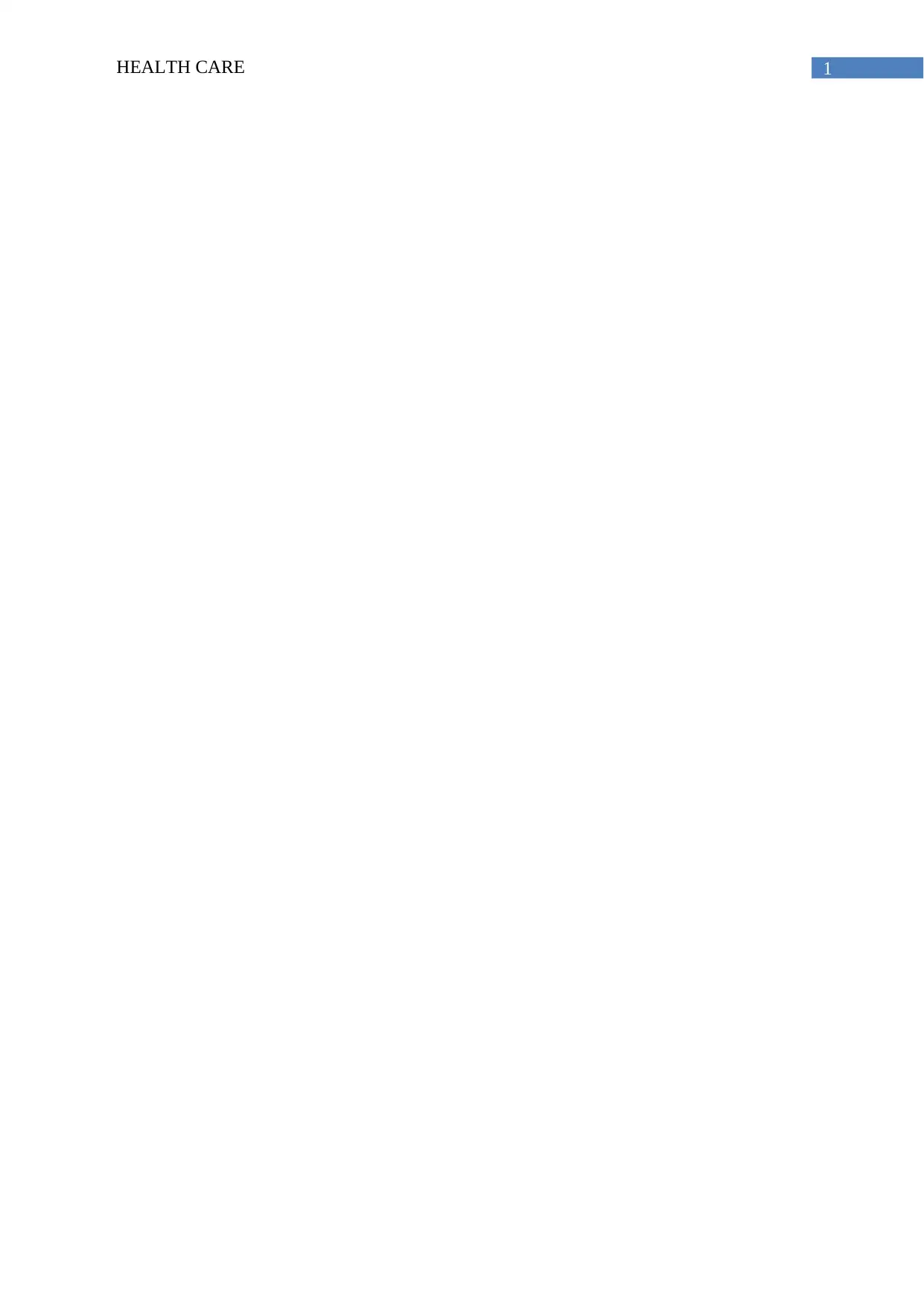
1HEALTH CARE
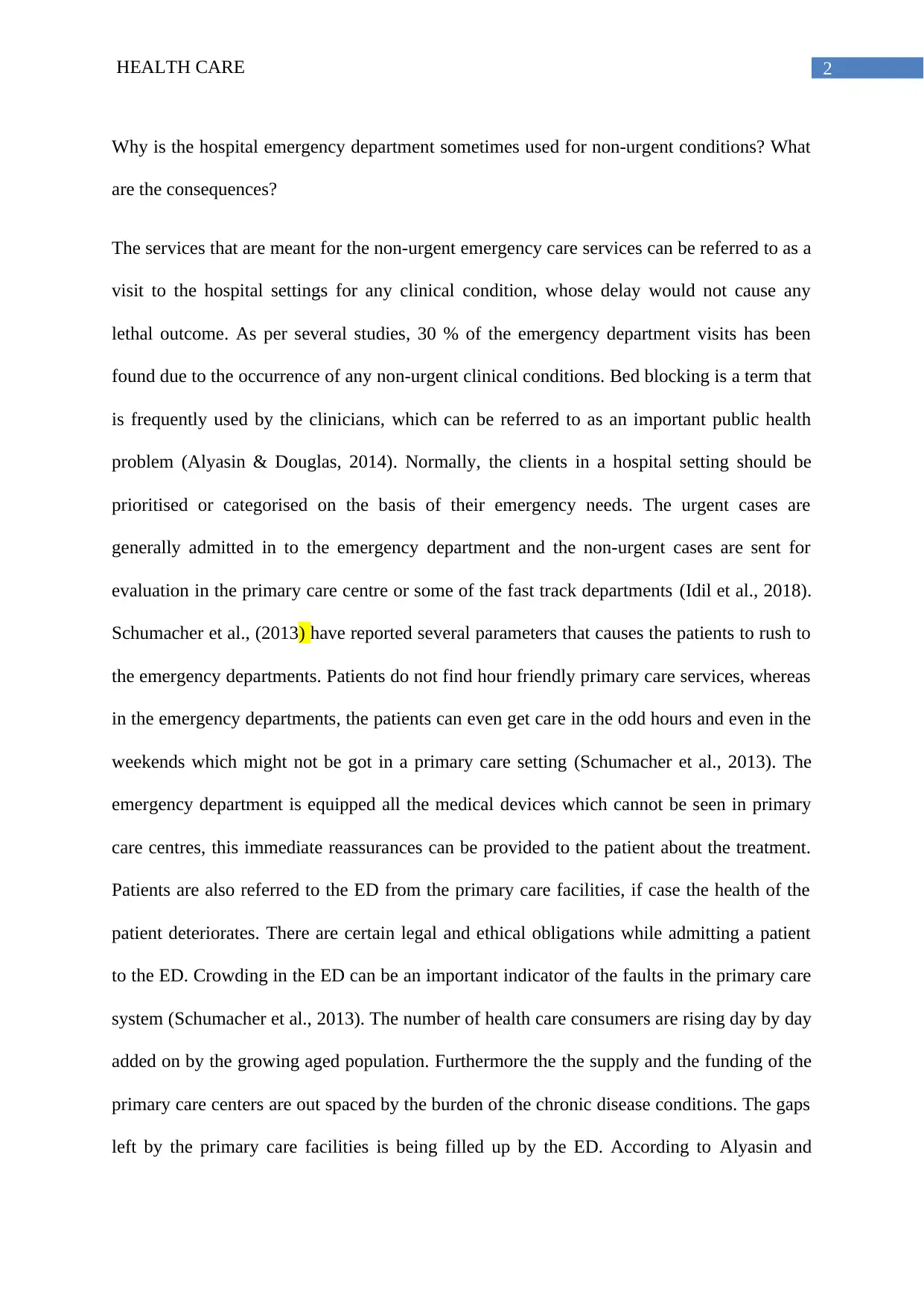
2HEALTH CARE
Why is the hospital emergency department sometimes used for non-urgent conditions? What
are the consequences?
The services that are meant for the non-urgent emergency care services can be referred to as a
visit to the hospital settings for any clinical condition, whose delay would not cause any
lethal outcome. As per several studies, 30 % of the emergency department visits has been
found due to the occurrence of any non-urgent clinical conditions. Bed blocking is a term that
is frequently used by the clinicians, which can be referred to as an important public health
problem (Alyasin & Douglas, 2014). Normally, the clients in a hospital setting should be
prioritised or categorised on the basis of their emergency needs. The urgent cases are
generally admitted in to the emergency department and the non-urgent cases are sent for
evaluation in the primary care centre or some of the fast track departments (Idil et al., 2018).
Schumacher et al., (2013) have reported several parameters that causes the patients to rush to
the emergency departments. Patients do not find hour friendly primary care services, whereas
in the emergency departments, the patients can even get care in the odd hours and even in the
weekends which might not be got in a primary care setting (Schumacher et al., 2013). The
emergency department is equipped all the medical devices which cannot be seen in primary
care centres, this immediate reassurances can be provided to the patient about the treatment.
Patients are also referred to the ED from the primary care facilities, if case the health of the
patient deteriorates. There are certain legal and ethical obligations while admitting a patient
to the ED. Crowding in the ED can be an important indicator of the faults in the primary care
system (Schumacher et al., 2013). The number of health care consumers are rising day by day
added on by the growing aged population. Furthermore the the supply and the funding of the
primary care centers are out spaced by the burden of the chronic disease conditions. The gaps
left by the primary care facilities is being filled up by the ED. According to Alyasin and
Why is the hospital emergency department sometimes used for non-urgent conditions? What
are the consequences?
The services that are meant for the non-urgent emergency care services can be referred to as a
visit to the hospital settings for any clinical condition, whose delay would not cause any
lethal outcome. As per several studies, 30 % of the emergency department visits has been
found due to the occurrence of any non-urgent clinical conditions. Bed blocking is a term that
is frequently used by the clinicians, which can be referred to as an important public health
problem (Alyasin & Douglas, 2014). Normally, the clients in a hospital setting should be
prioritised or categorised on the basis of their emergency needs. The urgent cases are
generally admitted in to the emergency department and the non-urgent cases are sent for
evaluation in the primary care centre or some of the fast track departments (Idil et al., 2018).
Schumacher et al., (2013) have reported several parameters that causes the patients to rush to
the emergency departments. Patients do not find hour friendly primary care services, whereas
in the emergency departments, the patients can even get care in the odd hours and even in the
weekends which might not be got in a primary care setting (Schumacher et al., 2013). The
emergency department is equipped all the medical devices which cannot be seen in primary
care centres, this immediate reassurances can be provided to the patient about the treatment.
Patients are also referred to the ED from the primary care facilities, if case the health of the
patient deteriorates. There are certain legal and ethical obligations while admitting a patient
to the ED. Crowding in the ED can be an important indicator of the faults in the primary care
system (Schumacher et al., 2013). The number of health care consumers are rising day by day
added on by the growing aged population. Furthermore the the supply and the funding of the
primary care centers are out spaced by the burden of the chronic disease conditions. The gaps
left by the primary care facilities is being filled up by the ED. According to Alyasin and
⊘ This is a preview!⊘
Do you want full access?
Subscribe today to unlock all pages.

Trusted by 1+ million students worldwide
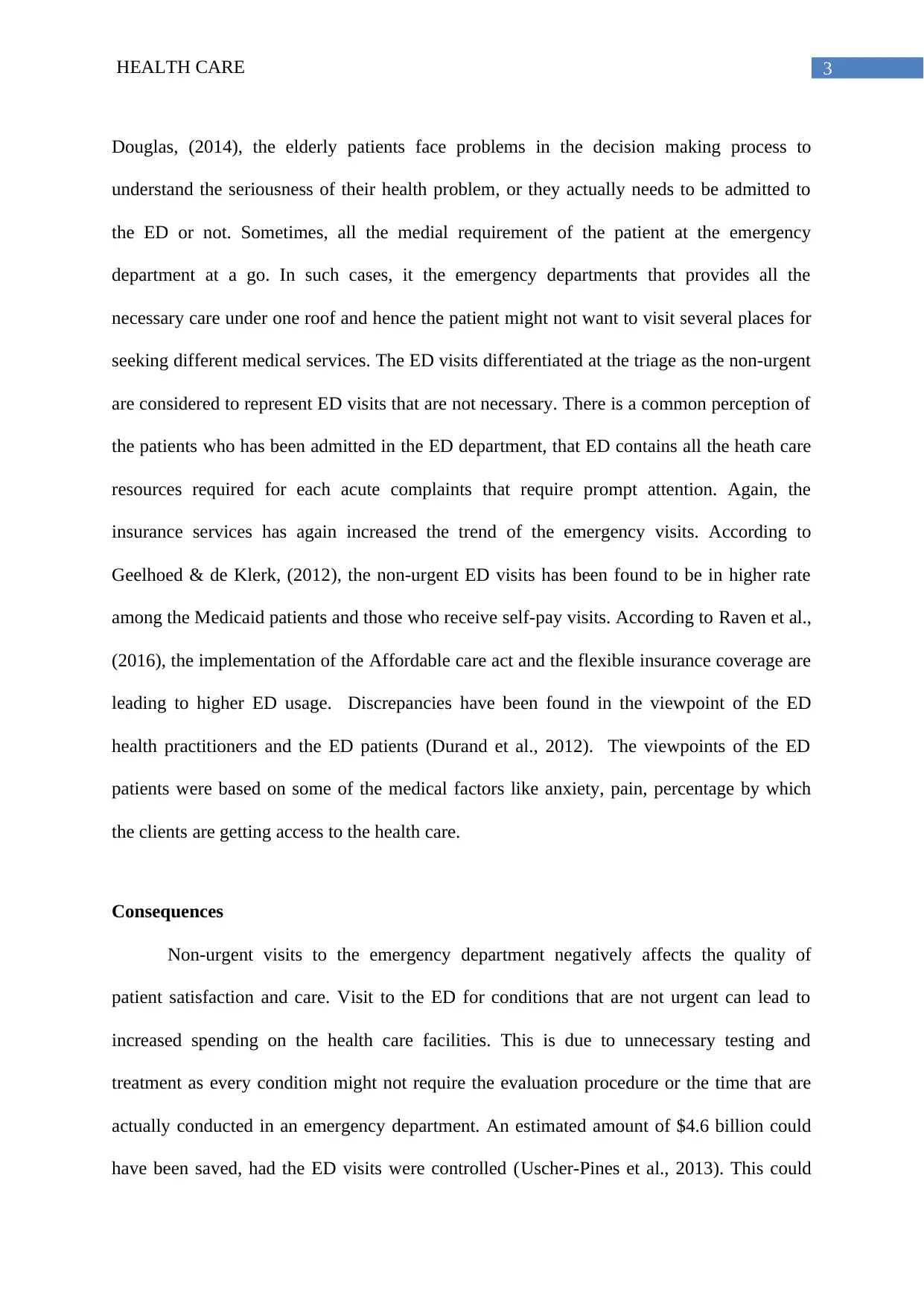
3HEALTH CARE
Douglas, (2014), the elderly patients face problems in the decision making process to
understand the seriousness of their health problem, or they actually needs to be admitted to
the ED or not. Sometimes, all the medial requirement of the patient at the emergency
department at a go. In such cases, it the emergency departments that provides all the
necessary care under one roof and hence the patient might not want to visit several places for
seeking different medical services. The ED visits differentiated at the triage as the non-urgent
are considered to represent ED visits that are not necessary. There is a common perception of
the patients who has been admitted in the ED department, that ED contains all the heath care
resources required for each acute complaints that require prompt attention. Again, the
insurance services has again increased the trend of the emergency visits. According to
Geelhoed & de Klerk, (2012), the non-urgent ED visits has been found to be in higher rate
among the Medicaid patients and those who receive self-pay visits. According to Raven et al.,
(2016), the implementation of the Affordable care act and the flexible insurance coverage are
leading to higher ED usage. Discrepancies have been found in the viewpoint of the ED
health practitioners and the ED patients (Durand et al., 2012). The viewpoints of the ED
patients were based on some of the medical factors like anxiety, pain, percentage by which
the clients are getting access to the health care.
Consequences
Non-urgent visits to the emergency department negatively affects the quality of
patient satisfaction and care. Visit to the ED for conditions that are not urgent can lead to
increased spending on the health care facilities. This is due to unnecessary testing and
treatment as every condition might not require the evaluation procedure or the time that are
actually conducted in an emergency department. An estimated amount of $4.6 billion could
have been saved, had the ED visits were controlled (Uscher-Pines et al., 2013). This could
Douglas, (2014), the elderly patients face problems in the decision making process to
understand the seriousness of their health problem, or they actually needs to be admitted to
the ED or not. Sometimes, all the medial requirement of the patient at the emergency
department at a go. In such cases, it the emergency departments that provides all the
necessary care under one roof and hence the patient might not want to visit several places for
seeking different medical services. The ED visits differentiated at the triage as the non-urgent
are considered to represent ED visits that are not necessary. There is a common perception of
the patients who has been admitted in the ED department, that ED contains all the heath care
resources required for each acute complaints that require prompt attention. Again, the
insurance services has again increased the trend of the emergency visits. According to
Geelhoed & de Klerk, (2012), the non-urgent ED visits has been found to be in higher rate
among the Medicaid patients and those who receive self-pay visits. According to Raven et al.,
(2016), the implementation of the Affordable care act and the flexible insurance coverage are
leading to higher ED usage. Discrepancies have been found in the viewpoint of the ED
health practitioners and the ED patients (Durand et al., 2012). The viewpoints of the ED
patients were based on some of the medical factors like anxiety, pain, percentage by which
the clients are getting access to the health care.
Consequences
Non-urgent visits to the emergency department negatively affects the quality of
patient satisfaction and care. Visit to the ED for conditions that are not urgent can lead to
increased spending on the health care facilities. This is due to unnecessary testing and
treatment as every condition might not require the evaluation procedure or the time that are
actually conducted in an emergency department. An estimated amount of $4.6 billion could
have been saved, had the ED visits were controlled (Uscher-Pines et al., 2013). This could
Paraphrase This Document
Need a fresh take? Get an instant paraphrase of this document with our AI Paraphraser
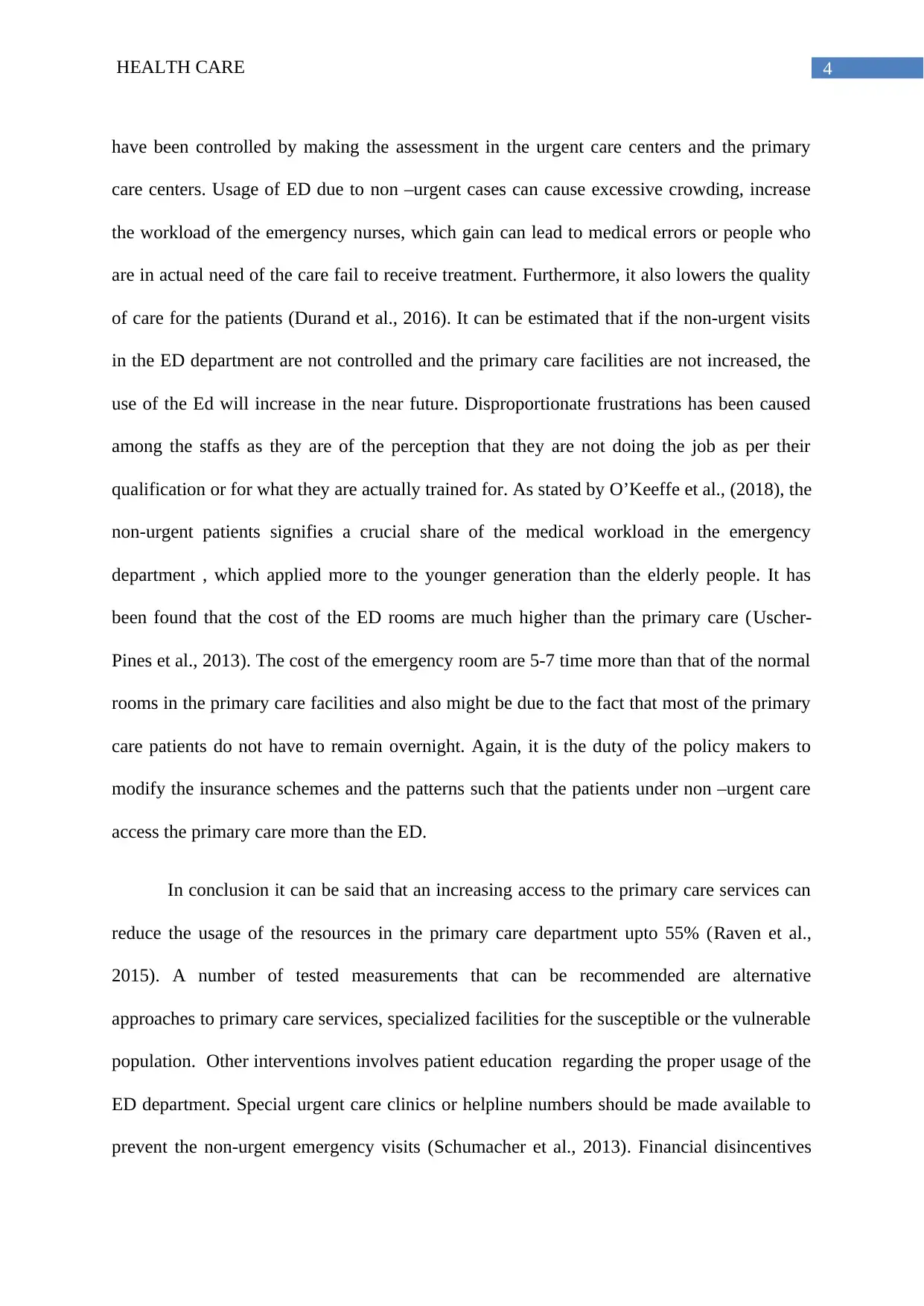
4HEALTH CARE
have been controlled by making the assessment in the urgent care centers and the primary
care centers. Usage of ED due to non –urgent cases can cause excessive crowding, increase
the workload of the emergency nurses, which gain can lead to medical errors or people who
are in actual need of the care fail to receive treatment. Furthermore, it also lowers the quality
of care for the patients (Durand et al., 2016). It can be estimated that if the non-urgent visits
in the ED department are not controlled and the primary care facilities are not increased, the
use of the Ed will increase in the near future. Disproportionate frustrations has been caused
among the staffs as they are of the perception that they are not doing the job as per their
qualification or for what they are actually trained for. As stated by O’Keeffe et al., (2018), the
non-urgent patients signifies a crucial share of the medical workload in the emergency
department , which applied more to the younger generation than the elderly people. It has
been found that the cost of the ED rooms are much higher than the primary care (Uscher-
Pines et al., 2013). The cost of the emergency room are 5-7 time more than that of the normal
rooms in the primary care facilities and also might be due to the fact that most of the primary
care patients do not have to remain overnight. Again, it is the duty of the policy makers to
modify the insurance schemes and the patterns such that the patients under non –urgent care
access the primary care more than the ED.
In conclusion it can be said that an increasing access to the primary care services can
reduce the usage of the resources in the primary care department upto 55% (Raven et al.,
2015). A number of tested measurements that can be recommended are alternative
approaches to primary care services, specialized facilities for the susceptible or the vulnerable
population. Other interventions involves patient education regarding the proper usage of the
ED department. Special urgent care clinics or helpline numbers should be made available to
prevent the non-urgent emergency visits (Schumacher et al., 2013). Financial disincentives
have been controlled by making the assessment in the urgent care centers and the primary
care centers. Usage of ED due to non –urgent cases can cause excessive crowding, increase
the workload of the emergency nurses, which gain can lead to medical errors or people who
are in actual need of the care fail to receive treatment. Furthermore, it also lowers the quality
of care for the patients (Durand et al., 2016). It can be estimated that if the non-urgent visits
in the ED department are not controlled and the primary care facilities are not increased, the
use of the Ed will increase in the near future. Disproportionate frustrations has been caused
among the staffs as they are of the perception that they are not doing the job as per their
qualification or for what they are actually trained for. As stated by O’Keeffe et al., (2018), the
non-urgent patients signifies a crucial share of the medical workload in the emergency
department , which applied more to the younger generation than the elderly people. It has
been found that the cost of the ED rooms are much higher than the primary care (Uscher-
Pines et al., 2013). The cost of the emergency room are 5-7 time more than that of the normal
rooms in the primary care facilities and also might be due to the fact that most of the primary
care patients do not have to remain overnight. Again, it is the duty of the policy makers to
modify the insurance schemes and the patterns such that the patients under non –urgent care
access the primary care more than the ED.
In conclusion it can be said that an increasing access to the primary care services can
reduce the usage of the resources in the primary care department upto 55% (Raven et al.,
2015). A number of tested measurements that can be recommended are alternative
approaches to primary care services, specialized facilities for the susceptible or the vulnerable
population. Other interventions involves patient education regarding the proper usage of the
ED department. Special urgent care clinics or helpline numbers should be made available to
prevent the non-urgent emergency visits (Schumacher et al., 2013). Financial disincentives
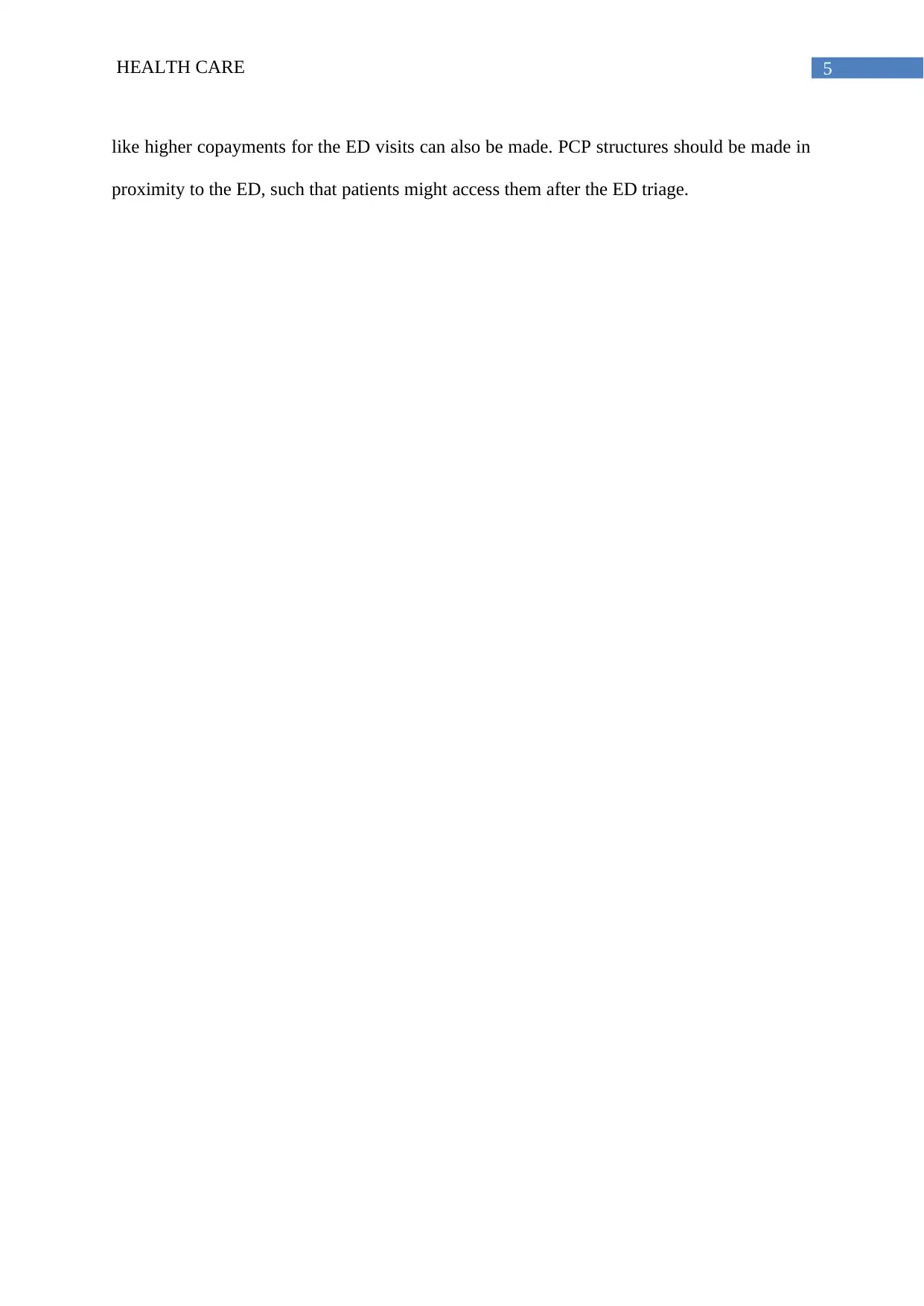
5HEALTH CARE
like higher copayments for the ED visits can also be made. PCP structures should be made in
proximity to the ED, such that patients might access them after the ED triage.
like higher copayments for the ED visits can also be made. PCP structures should be made in
proximity to the ED, such that patients might access them after the ED triage.
⊘ This is a preview!⊘
Do you want full access?
Subscribe today to unlock all pages.

Trusted by 1+ million students worldwide
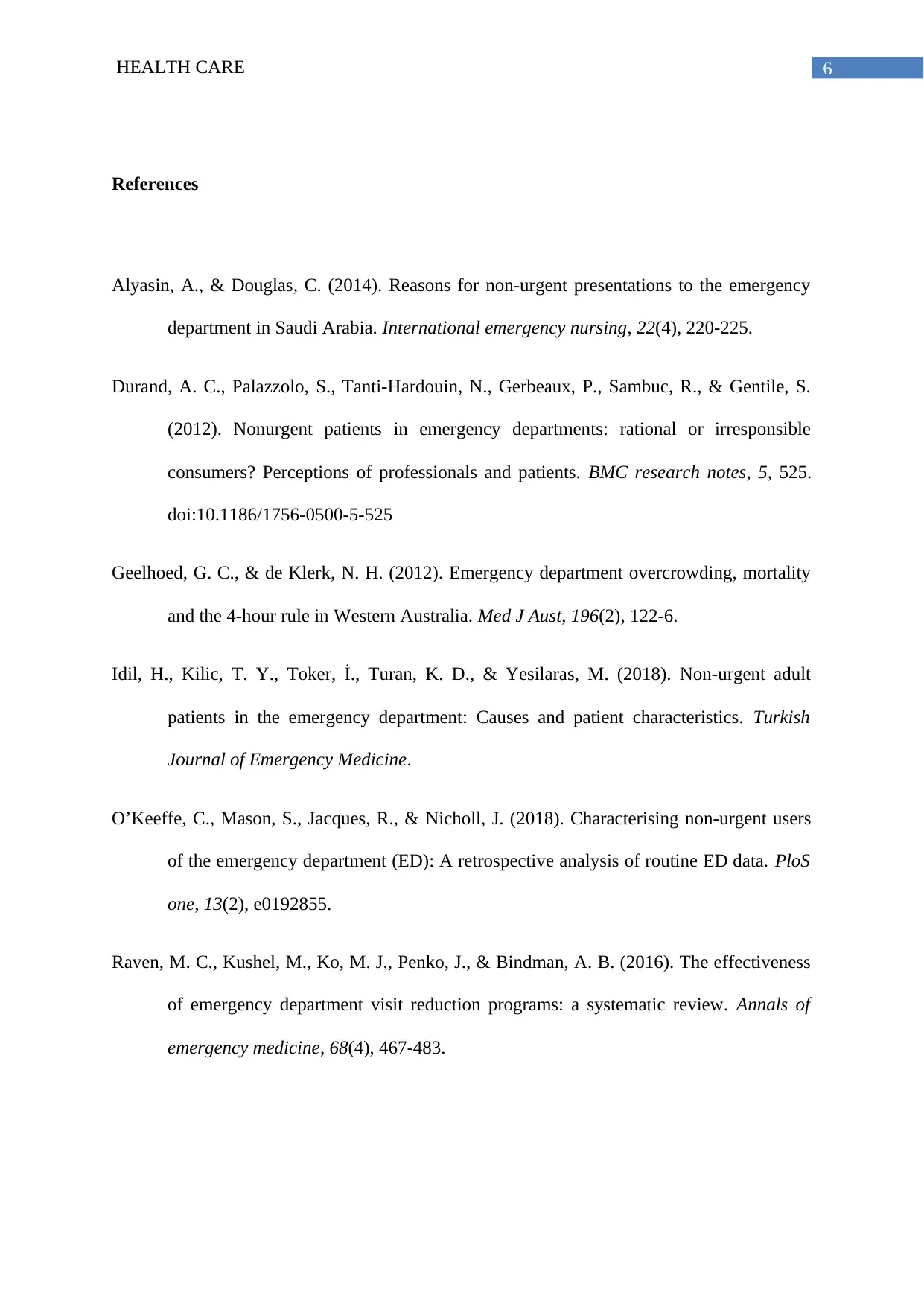
6HEALTH CARE
References
Alyasin, A., & Douglas, C. (2014). Reasons for non-urgent presentations to the emergency
department in Saudi Arabia. International emergency nursing, 22(4), 220-225.
Durand, A. C., Palazzolo, S., Tanti-Hardouin, N., Gerbeaux, P., Sambuc, R., & Gentile, S.
(2012). Nonurgent patients in emergency departments: rational or irresponsible
consumers? Perceptions of professionals and patients. BMC research notes, 5, 525.
doi:10.1186/1756-0500-5-525
Geelhoed, G. C., & de Klerk, N. H. (2012). Emergency department overcrowding, mortality
and the 4-hour rule in Western Australia. Med J Aust, 196(2), 122-6.
Idil, H., Kilic, T. Y., Toker, İ., Turan, K. D., & Yesilaras, M. (2018). Non-urgent adult
patients in the emergency department: Causes and patient characteristics. Turkish
Journal of Emergency Medicine.
O’Keeffe, C., Mason, S., Jacques, R., & Nicholl, J. (2018). Characterising non-urgent users
of the emergency department (ED): A retrospective analysis of routine ED data. PloS
one, 13(2), e0192855.
Raven, M. C., Kushel, M., Ko, M. J., Penko, J., & Bindman, A. B. (2016). The effectiveness
of emergency department visit reduction programs: a systematic review. Annals of
emergency medicine, 68(4), 467-483.
References
Alyasin, A., & Douglas, C. (2014). Reasons for non-urgent presentations to the emergency
department in Saudi Arabia. International emergency nursing, 22(4), 220-225.
Durand, A. C., Palazzolo, S., Tanti-Hardouin, N., Gerbeaux, P., Sambuc, R., & Gentile, S.
(2012). Nonurgent patients in emergency departments: rational or irresponsible
consumers? Perceptions of professionals and patients. BMC research notes, 5, 525.
doi:10.1186/1756-0500-5-525
Geelhoed, G. C., & de Klerk, N. H. (2012). Emergency department overcrowding, mortality
and the 4-hour rule in Western Australia. Med J Aust, 196(2), 122-6.
Idil, H., Kilic, T. Y., Toker, İ., Turan, K. D., & Yesilaras, M. (2018). Non-urgent adult
patients in the emergency department: Causes and patient characteristics. Turkish
Journal of Emergency Medicine.
O’Keeffe, C., Mason, S., Jacques, R., & Nicholl, J. (2018). Characterising non-urgent users
of the emergency department (ED): A retrospective analysis of routine ED data. PloS
one, 13(2), e0192855.
Raven, M. C., Kushel, M., Ko, M. J., Penko, J., & Bindman, A. B. (2016). The effectiveness
of emergency department visit reduction programs: a systematic review. Annals of
emergency medicine, 68(4), 467-483.
Paraphrase This Document
Need a fresh take? Get an instant paraphrase of this document with our AI Paraphraser
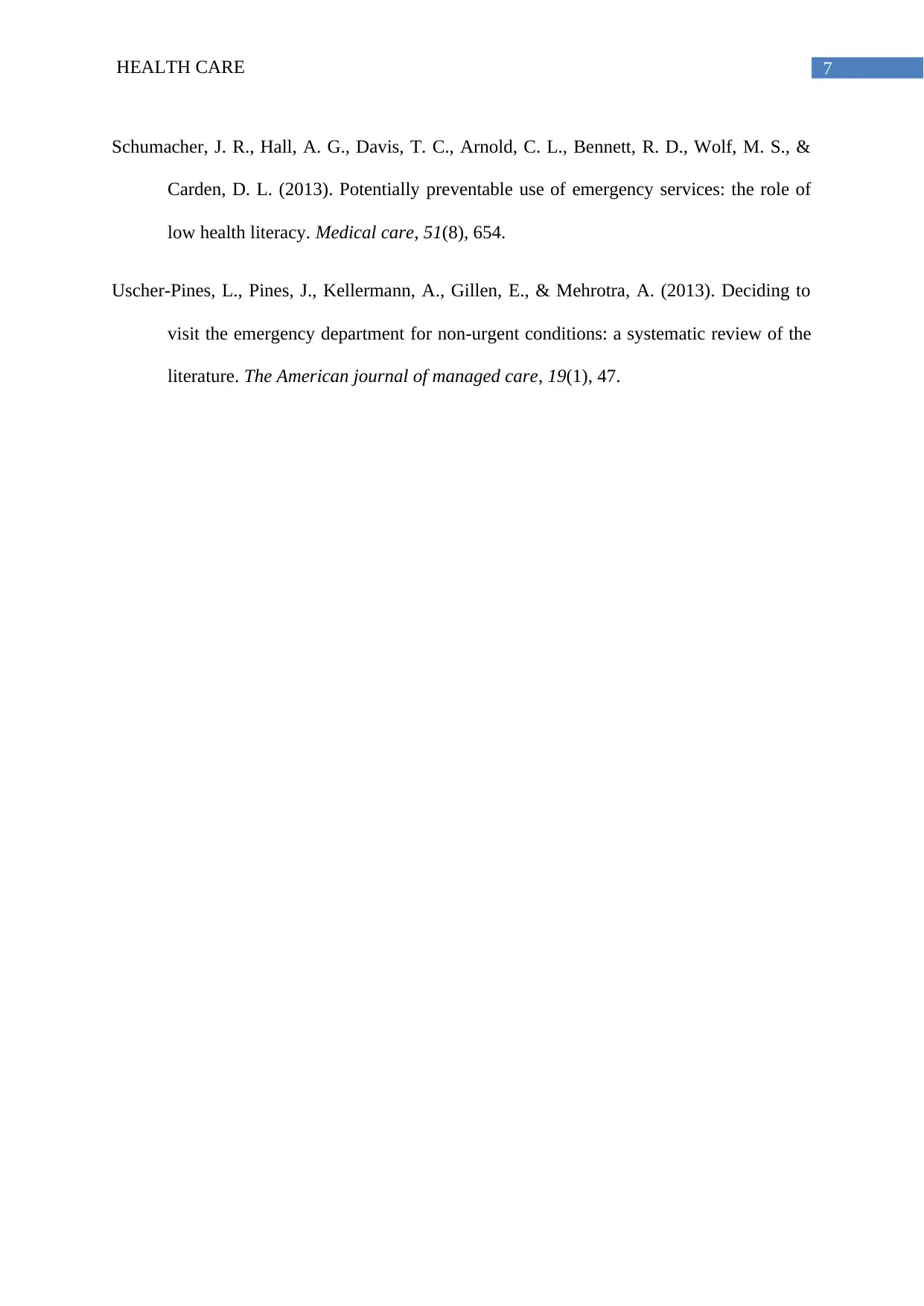
7HEALTH CARE
Schumacher, J. R., Hall, A. G., Davis, T. C., Arnold, C. L., Bennett, R. D., Wolf, M. S., &
Carden, D. L. (2013). Potentially preventable use of emergency services: the role of
low health literacy. Medical care, 51(8), 654.
Uscher-Pines, L., Pines, J., Kellermann, A., Gillen, E., & Mehrotra, A. (2013). Deciding to
visit the emergency department for non-urgent conditions: a systematic review of the
literature. The American journal of managed care, 19(1), 47.
Schumacher, J. R., Hall, A. G., Davis, T. C., Arnold, C. L., Bennett, R. D., Wolf, M. S., &
Carden, D. L. (2013). Potentially preventable use of emergency services: the role of
low health literacy. Medical care, 51(8), 654.
Uscher-Pines, L., Pines, J., Kellermann, A., Gillen, E., & Mehrotra, A. (2013). Deciding to
visit the emergency department for non-urgent conditions: a systematic review of the
literature. The American journal of managed care, 19(1), 47.
1 out of 8
Related Documents
Your All-in-One AI-Powered Toolkit for Academic Success.
+13062052269
info@desklib.com
Available 24*7 on WhatsApp / Email
![[object Object]](/_next/static/media/star-bottom.7253800d.svg)
Unlock your academic potential
Copyright © 2020–2025 A2Z Services. All Rights Reserved. Developed and managed by ZUCOL.





